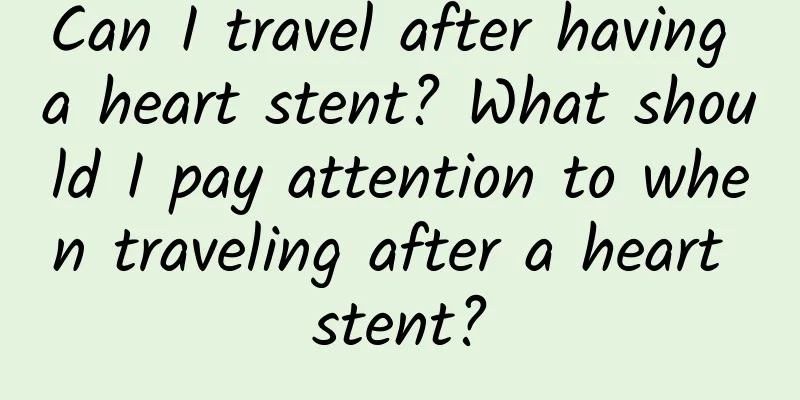Can I travel after having a heart stent? What should I pay attention to when traveling after a heart stent?

|
Heart stents are a method of treating coronary heart disease, mainly to help the blood in the arteries circulate normally. Generally speaking, stent implantation will not affect normal life, work and study, so can you travel after having a heart stent? Can I travel if I have a heart stent?Of course you can go if the situation allows after having a stent placed, but all cardiovascular doctors remind those who have had a stent placed to pay attention to some taboos in life, such as staying away from tobacco and alcohol, not staying up late, not overworking, exercising appropriately, controlling blood pressure, paying attention to diet structure, etc. In the process of long-distance travel or tourism, these precautions are often easily broken. Therefore, people with coronary heart disease or who have had heart stents should carefully consider long-distance travel. The following situations require careful consideration of travel risks: First, patients with acute myocardial infarction need proper rest to allow the myocardium to recover even after stent implantation. Second, patients with concomitant heart failure need to consider their heart function to decide whether to travel. Third, if there is a main branch vessel that has not yet been revascularized, then revascularization should be considered before further treatment. Fourth, if there is a severe arrhythmia induced by coronary heart disease, but relevant prevention and treatment have not yet been carried out, it is necessary to be cautious when traveling. What should you pay attention to when traveling after heart stent surgery?1. Choice of travel destination. It is not advisable to choose high altitude hypoxic areas or extremely cold areas, because these places may induce myocardial ischemia and hypoxia, resulting in angina pectoris or even myocardial infarction. 2. Choice of travel tools. It is recommended to choose stable and fast means of transportation such as high-speed rail and airplanes. Long-distance buses are not suitable. If you drive yourself, you can consider renting a car at the destination. 3. Preparation before traveling. Prepare enough medicines, including daily medicines and emergency medicines, such as nitroglycerin and quick-acting heart-saving pills. Carry a blood pressure monitor. It is not advisable to use nitroglycerin when chest tightness, chest pain and low blood pressure occur. It is best to go to the hospital for a check-up and ask the doctor to evaluate the current situation to see if it is suitable for traveling. Patients with recurrent angina pectoris are not suitable for traveling and need early treatment. 4. During the tour, it is not advisable to overwork. It is best to form a small group with your family, or travel independently without a group. This will make it easier, you can control your own time, and have a more comfortable time. You can also prepare a wheelchair so that patients with coronary heart disease can push it when they feel tired. 5. Another point is that although you can travel after stent surgery, there is currently no recognized recommended time for how long you can go out. Dr. Xu personally recommends that it is best not to go out within one month, because the risk of thrombosis in the stent is higher within one month, and the risk is much lower after one month. The role of heart stentsPatients with coronary heart disease will consider heart stents when the coronary artery stenosis reaches more than 75%. That is, a stent is placed in the narrowed or even blocked coronary blood vessels. The stent is made of metal and will open like an umbrella to hold the blood vessels open, keep the blood flow unobstructed, and quickly improve the blood supply to the heart. However, this stent is not a permanent solution. First of all, when the stent is opened, the endothelium of the blood vessel will be damaged to a certain extent, and the blood will be more likely to coagulate into blood clots. In addition, this stent is currently made of metal with drug coating, and it becomes bumpy when pressed on the surface of the blood vessel. When blood passes through here, the flow rate slows down and it is easy to gather and form blood clots. Therefore, it is generally necessary to use two anticoagulant drugs in combination after surgery, usually aspirin plus clopidogrel. |
Recommend
Are moles the precursors of melanoma? Be careful when these 4 changes occur on moles on your body!
gossip Recently, the 36-year-old singer Zhang Hen...
What to do if your back feels cold during the confinement period
A cold back is a common problem during the confin...
Can I eat Houttuynia during menstruation?
Many people may have big doubts about whether the...
Morning sickness feels better after vomiting yellow water
It is a very normal physiological phenomenon for ...
Does hysteroscopy cause damage to the uterus?
The uterus is an important reproductive organ for...
Is my tight belly a sign of pregnancy?
Women will experience many uncomfortable symptoms...
Causes of intermittent bleeding after abortion
When women undergo abortion, they must be prepare...
How to treat plasma cell mastitis in traditional Chinese medicine
Breasts are a very important part of a woman. In ...
How many days after the end of menstruation is the safe period?
In today's life, many women don't know mu...
Don’t eat the wrong foods if you have uterine fibroids! 4 kinds of landmine foods to avoid
In traditional Chinese medicine, uterine fibroids...
How to reduce belly fat? Chinese medicine for slimming belly
For women, having children is the top priority in...
SME: 2019 Social Media Marketing Industry Report
SME (Social Media Examiner) released the "20...
Can your fat be broken down by not eating staple foods? Uncover the truth about the ketogenic diet!
Losing weight can be said to be a lifelong career...
"People infected with COVID-19 have long-term abnormal lung function"? A secret to debunk this rumor
If you interpret the paper carefully, you will fi...
Why does your face turn red or pale when you drink? The scientific explanation of how much alcohol you drink and why your face turns red or pale when you drink
"Are people who turn red when drinking more ...









